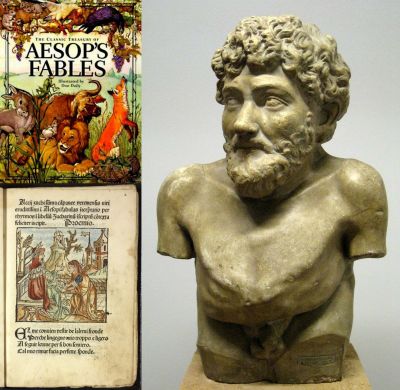The oldest known storyteller of humanity: Who is Aisopos?
The information about the life of Aisopos, who gained great fame with his tales whose heroes were animals, is not certain.

(6th century BC) Ancient Greek fable writer. His works have been the source of fairy tale literature in all languages. There are various claims regarding the birthplace of Aisopos, whose real life has been the subject of debate since the Renaissance. Various clues on his life story are given by Herodotus and Plutarch; According to some sources, it is claimed that he is Thracian, and according to some sources, he is Phrygian. The most widely accepted among them is that he was a slave of a noble named Ladmon on the island of Samos, wandered a lot after being freed by his owner, and was killed in Delphi. The story of death has a mythological narrative. It is alleged that he insulted the Delphians, claiming that they lived for a long time by stealing from the lives of others with the help of their gods. Thereupon, he was caught as a thief by the people of the city and executed.
Aristophanes included Aisopos in his comedy called Flies; Socrates mentioned him in his speeches in the last hours of waiting for death. The first tidy writing of the fables of Aisopos was carried out by Demetrius Phalareus in the 4th century BC, but these have not survived. Later, the tales collected by Phædrus in Rome in the 1st century were published in Latin. Fables, which have been republished many times over the ages, have gained worldwide popularity, especially when re-evaluated by the 17th-century French writer Jean de la Fontaine.
In the fables of Aisopos, the relations of a new universe consisting of animals, each of which has assumed different human characteristics, are discussed. Sovereignty fights, the efforts of the strong to oppress and destroy the weak, cooperation, envy, playmaking, animals are given with all their strikingness in the abstraction of the universe. Aisopos took refuge in this abstraction and ruthlessly criticized the period in which he lived, in a spectrum ranging from everyday human behavior to the forms of government of the countries.
Animal tales, which are now considered children's tales, were circulated in ancient times and were used by adults to support arguments in discussions about important issues and big decisions. These tales were also used abundantly in the education and philosophy discussions of that period, both to add color to the speeches and as evidence. At the end of the tales and drawing conclusions for humans from the relationship between animals, the "scenes from the story" summarized the lesson to be given. It is not known for certain whether these were added later or were an original part of the tales. The fact that these fables, which are around 250 in total, can transfer the flaws in human behavior to the present day without losing anything from their strikingness, is an indication that Aisopos is an important witness of his age.
